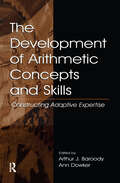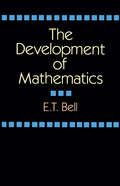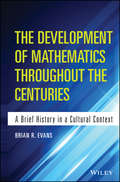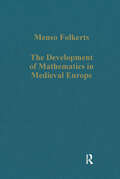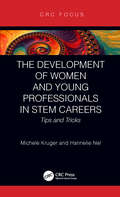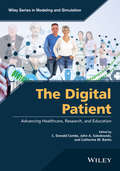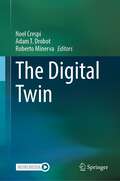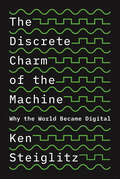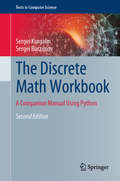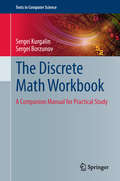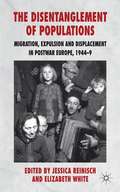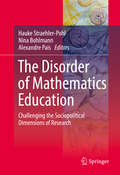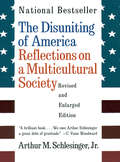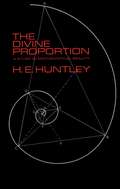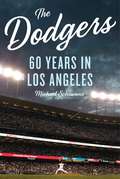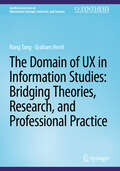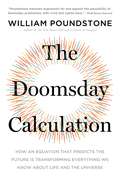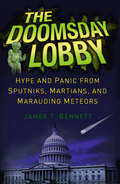- Table View
- List View
The Design Inference
by William A. DembskiThe design inference uncovers intelligent causes by isolating their key trademark: specified events of small probability. Just about anything that happens is highly improbable, but when a highly improbable event is also specified (i. e. conforms to an independently given pattern) undirected natural causes lose their explanatory power. Design inferences can be found in a range of scientific pursuits from forensic science to research into the origins of life to the search for extraterrestrial intelligence. This challenging and provocative book shows how incomplete undirected causes are for science and breathes new life into classical design arguments. It will be read with particular interest by philosophers of science and religion, other philosophers concerned with epistemology and logic, probability and complexity theorists, and statisticians.
The Design of Approximation Algorithms
by David P. Williamson David B. ShmoysDiscrete optimization problems are everywhere, from traditional operations research planning (scheduling, facility location and network design); to computer science databases; to advertising issues in viral marketing. Yet most such problems are NP-hard; unless P = NP, there are no efficient algorithms to find optimal solutions. This book shows how to design approximation algorithms: efficient algorithms that find provably near-optimal solutions. The book is organized around central algorithmic techniques for designing approximation algorithms, including greedy and local search algorithms, dynamic programming, linear and semidefinite programming, and randomization. Each chapter in the first section is devoted to a single algorithmic technique applied to several different problems, with more sophisticated treatment in the second section. The book also covers methods for proving that optimization problems are hard to approximate. Designed as a textbook for graduate-level algorithm courses, it will also serve as a reference for researchers interested in the heuristic solution of discrete optimization problems.
The Design of Approximation Algorithms
by David P. Williamson David B. ShmoysDiscrete optimization problems are everywhere, from traditional operations research planning (scheduling, facility location and network design); to computer science databases; to advertising issues in viral marketing. Yet most such problems are NP-hard; unless P = NP, there are no efficient algorithms to find optimal solutions. This book shows how to design approximation algorithms: efficient algorithms that find provably near-optimal solutions. The book is organized around central algorithmic techniques for designing approximation algorithms, including greedy and local search algorithms, dynamic programming, linear and semidefinite programming, and randomization. Each chapter in the first section is devoted to a single algorithmic technique applied to several different problems, with more sophisticated treatment in the second section. The book also covers methods for proving that optimization problems are hard to approximate. Designed as a textbook for graduate-level algorithm courses, it will also serve as a reference for researchers interested in the heuristic solution of discrete optimization problems.
The Development of Arithmetic Concepts and Skills: Constructive Adaptive Expertise (Studies in Mathematical Thinking and Learning Series)
by Ann Dowker Arthur J. BaroodyThis volume focuses on two related questions that are central to both the psychology of mathematical thinking and learning and to the improvement of mathematics education: What is the nature of arithmetic expertise? How can instruction best promote it? Contributors from a variety of specialities, including cognitive, developmental, educational, and neurological psychology; mathematics education; and special education offer theoretical perspectives and much needed empirical evidence about these issues. As reported in this volume, both theory and research indicate that the nature of arithmetic expertise and how to best promote it are far more complex than conventional wisdom and many scholars, past and present, have suggested. The results of psychological, educational, and clinical studies using a wide range of arithmetic tasks and populations (including "normally" and atypically developing children, non-injured and brain-injured adults, and savants) all point to the same conclusion: The heart of arithmetic fluency, in general, and the flexible and creative use of strategies, in particular, is what is termed "adaptive expertise" (meaningful or conceptually based knowledge). The construction of adaptive expertise in mathematics is, for the first time, examined across various arithmetic topics and age groups. This book will be an invaluable resource for researchers and graduate students interested in mathematical cognition and learning (including mathematics educators, developmental and educational psychologists, and neuropsychologists), educators (including teachers, curriculum supervisors, and school administrators), and others interested in improving arithmetic instruction (including officials in national and local education departments, the media, and parents).
The Development of Mathematics
by E. T. Bell"This important book . . . presents a broad account of the part played by mathematics in the evolution of civilization, describing clearly the main principles, methods, and theories of mathematics that have survived from about 4000 BC to 1940."- BooklistIn this time-honored study, one of the 20th century's foremost scholars and interpreters of the history and meaning of mathematics masterfully outlines the development of its leading ideas, and clearly explains the mathematics involved in each. According to the author, a professor of mathematics at the California Institute of Technology from 1926 until his death in 1960, it is "not a history of the traditional kind, but a narrative of the decisive epochs in the development of mathematics." It is a narrative filled with compelling insights of special interest to every mathematician, engineer, and scientist.Main trends in mathematics from approximately 4000 BC to the 20th century are presented through analyses of typical major episodes in each. The author first examines the evolution of mathematical ideas in the ancient civilizations of Egypt and Babylonia; later developments in India, Arabia, and Spain; and other achievements worldwide through the 16th century. Professor Bell then traces the beginnings of modern mathematics in the 17th century, and the emergence of the importance of extensions of number, mathematical structure, the generalization of arithmetic, and structural analysis. Compelling accounts of major breakthroughs in the 19th and 20th centuries follow, emphasizing rational arithmetic after Fermat, contributions from geometry, and topics as diverse as generalized variables, abstractions, differential equations, invariance, uncertainties, and probabilities. Throughout, Professor Bell subordinates details of mere antiquarian interest - involving concepts and ideas that did not succeed or bear fruit - in favor of the fullest possible exposition of those elements still alive in mathematics.
The Development of Mathematics Throughout the Centuries: A Brief History in a Cultural Context
by Brian EvansThroughout the book, readers take a journey throughout time and observe how people around the world have understood these patterns of quantity, structure, and dimension around them. The Development of Mathematics Throughout the Centuries: A Brief History in a Cultural Contex provides a brief overview of the history of mathematics in a very straightforward and understandable manner and also addresses major findings that influenced the development of mathematics as a coherent discipline. This book: Highlights the contributions made by various world cultures including African, Egyptian, Babylonian, Chinese, Indian, Islamic, and pre-Columbian American mathematics Features an approach that is not too rigorous and is ideal for a one-semester course of the history of mathematics. Includes a Resources and Recommended Reading section for further exploration and has been extensively classroom-tested
The Development of Mathematics in Medieval Europe: The Arabs, Euclid, Regiomontanus (Variorum Collected Studies)
by Menso FolkertsThe Development of Mathematics in Medieval Europe complements the previous collection of articles by Menso Folkerts, Essays on Early Medieval Mathematics, and deals with the development of mathematics in Europe from the 12th century to about 1500. In the 12th century European learning was greatly transformed by translations from Arabic into Latin. Such translations in the field of mathematics and their influence are here described and analysed, notably al-Khwarizmi's "Arithmetic" -- through which Europe became acquainted with the Hindu-Arabic numerals -- and Euclid's "Elements". Five articles are dedicated to Johannes Regiomontanus, perhaps the most original mathematician of the 15th century, and to his discoveries in trigonometry, algebra and other fields. The knowledge and application of Euclid's "Elements" in 13th- and 15th-century Italy are discussed in three studies, while the last article treats the development of algebra in South Germany around 1500, where much of the modern symbolism used in algebra was developed.
The Development of Women and Young Professionals in STEM Careers: Tips and Tricks (CRC Press Focus Shortform Book Program)
by Michele Kruger Hannelie NelThis book is fluent and systematic. The authors work through the fears and ambitions of young people new to STEM careers in the professional environment. Often, there is a lack of mentors, which leaves a young STEM practitioner exposed and doubting their own abilities. This book encourages young professionals and women in STEM careers to know that they are not alone and provides insight into their ability to deal with the stress of developing into a successful professional. Features Presents a method or vehicle to fast track young professionals and women in STEM Includes key issues that they should be aware of as they grow and develop in their education and field Describes how STEM career women are owners of their own path and provides an understanding of engineering and the business of consulting Conveys how young professionals and women in STEM can be aware of their own productivity and enjoy what they do and the career path they have selected This book is ideal for those new to the engineering, science, and consulting fields, including students in science and engineering education, administrators, libraries, those involved in leadership, organization behavior, human resources, STEM, and other areas as well.
The Development of the Action Principle: A Didactic History from Euler-Lagrange to Schwinger (SpringerBriefs in Physics)
by Walter DittrichThis book describes the historical development of the principle of stationary action from the 17th to the 20th centuries. Reference is made to the most important contributors to this topic, in particular Bernoullis, Leibniz, Euler, Lagrange and Laplace. The leading theme is how the action principle is applied to problems in classical physics such as hydrodynamics, electrodynamics and gravity, extending also to the modern formulation of quantum mechanics and quantum field theory, especially quantum electrodynamics. A critical analysis of operator versus c-number field theory is given. The book contains many worked examples. In particular, the term "vacuum" is scrutinized.The book is aimed primarily at actively working researchers, graduate students and historians interested in the philosophical interpretation and evolution of physics; in particular, in understanding the action principle and its application to a wide range of natural phenomena.
The Developments and the Applications of the Numerical Algorithms in Simulating the Incompressible Magnetohydrodynamics with Complex Boundaries and Free Surfaces (Springer Theses)
by Jie ZhangThis thesis presents an accurate and advanced numerical methodology to remedy difficulties such as direct numerical simulation of magnetohydrodynamic (MHD) flow in computational fluid dynamics (CFD), grid generation processes in tokamak fusion facilities, and the coupling between the surface tension force and Lorentz force in the metallurgical industry. In addition, on the basis of the numerical platform it establishes, it also investigates selected interesting topics, e.g. single bubble motion under the influence of either vertical or horizontal magnetic fields. Furthermore, it confirms the relation between the bubble’s path instability and wake instability, and observes the anisotropic (isotropic) effect of the vertical (horizontal) magnetic field on the vortex structures, which determines the dynamic behavior of the rising bubble. The direct numerical simulation of magnetohydrodynamic (MHD) flows has proven difficult in the field of computational fluid dynamic (CFD) research, because it not only concerns the coupling of the equations governing the electromagnetic field and the fluid motion, but also calls for suitable numerical methods for computing the electromagnetic field. In tokamak fusion facilities, where the MHD effect is significant and the flow domain is complex, the process of grid generation requires considerable time and effort. Moreover, in the metallurgical industry, where multiphase MHD flows are usually encountered, the coupling between the surface tension force and Lorentz force adds to the difficulty of deriving direct numerical simulations.
The Dialectic Relation Between Physics and Mathematics in the XIXth Century
by Raffaele Pisano Evelyne BarbinThe aim of this book is to analyse historical problems related to the use of mathematics in physics as well as to the use of physics in mathematics and to investigate Mathematical Physics as precisely the new discipline which is concerned with this dialectical link itself. So the main question is: When and why did the tension between mathematics and physics, explicitly practised at least since Galileo, evolve into such a new scientific theory? The authors explain the various ways in which this science allowed an advanced mathematical modelling in physics on the one hand, and the invention of new mathematical ideas on the other hand. Of course this problem is related to the links between institutions, universities, schools for engineers, and industries, and so it has social implications as well. The link by which physical ideas had influenced the world of mathematics was not new in the 19th century, but it came to a kind of maturity at that time. Recently, much historical research has been done into mathematics and physics and their relation in this period. The purpose of the Symposium and this book is to gather and re-evaluate the current thinking on this subject. It brings together contributions from leading experts in the field, and gives much-needed insight in the subject of mathematical physics from a historical point of view.
The Didactics of Mathematics: Approaches and Issues
by Jean-Baptiste Lagrange Bernard R. Hodgson Alain KuzniakThis book, the outcome of a conference organised in 2012 in Paris as a homage to Michèle Artigue, is based on its main components. However, it offers more than a mere reflection of this event in itself, as various well-known researchers from the field have been invited to summarize the main topics where the importance of Artigue's contribution is unquestionable. Her multiple interest areas, as a researcher involved in a wider community, give to this volume its unique flavour of diversity. Michèle Artigue (ICMI 2013 Felix Klein Award, CIAEM 2015 Luis Santaló Award) is without doubt one of the most influential researchers nowadays in the field of didactics of mathematics. This influence rests both on the quality of her research and on her constant contribution, since the early 1970s, to the development of the teaching and learning of mathematics. Observing her exemplary professional history, one can witness the emergence, the development, and the main issues of didactics of mathematics as a specific research field.
The Digital Patient
by Catherine M. Banks John A. Sokolowski C. D. CombsA modern guide to computational models and constructive simulation for personalized patient care using the Digital Patient The healthcare industry's emphasis is shifting from merely reacting to disease to preventing disease and promoting wellness. Addressing one of the more hopeful Big Data undertakings, The Digital Patient: Advancing Healthcare, Research, and Education presents a timely resource on the construction and deployment of the Digital Patient and its effects on healthcare, research, and education. The Digital Patient will not be constructed based solely on new information from all the "omics" fields, which includes systems analysis, Big Data, as well as the various efforts to model the human physiome and represent it virtually. The Digital Patient will be realized through the purposeful collaboration of patients as well as scientific, clinical, and policy researchers, from both their own research and through the development of an effective framework into which their research will fit. The Digital Patient: Advancing Healthcare, Research, and Education addresses the international research efforts that are leading to the development of the Digital Patient, the wealth of ongoing research in systems biology and multi-scale simulation, and the imminent applications within the domain of personalized healthcare. Chapter coverage includes: The visible human The physiological human The virtual human Research in systems biology Multi-scale modeling Personalized medicine Self-quantification Visualization Computational modeling Interdisciplinary collaboration The Digital Patient: Advancing Healthcare, Research, and Education is a useful reference for simulation professionals such as clinicians, medical directors, managers, simulation technologists, faculty members, and educators involved in research and development in the life sciences, physical sciences, and engineering. The book is also an ideal supplement for graduate-level courses related to human modeling, simulation, and visualization.
The Digital Twin
by Roberto Minerva Noel Crespi Adam T. DrobotThe Digital Twin is crucial and timely for positively affecting how we work, live, and play. It eliminates the gap between experimentation and learning by bridging real and virtual worlds in a powerful methodology, making significant headway in conquering previously unsolvable problems and challenges. Digital Twins are made possible by four widely deployed infrastructures for connectivity, computing, digital storage, and sources of digital data. The Digital Twin provides insights, paths to innovation, efficient production of goods, improved delivery of services, better experiences and entertainment, and new business models. Investing in Digital Twins is one of the most valuable ways to create sustainable paths to the future. The Digital Twin book is the most comprehensive work on the subject to date. It brings together top practitioners, technical experts, analysts, and academics to explore and discuss the concept of the Digital Twin, its history, evolution, and the profound impact across sectors of the global economy. The book addresses the business value, technological underpinnings, lessons learned from implementations, resources for success, practical approaches for implementation, and illustrative use cases. It makes the case for why we believe that Digital Twins will fundamentally transform major industries and enable us to fulfill important societal goals. The book is recommended for key decision makers, senior executives, technical leaders, researchers, and students.
The Discrete Charm of the Machine: Why the World Became Digital
by Ken SteiglitzThe genesis of the digital idea and why it transformed civilizationA few short decades ago, we were informed by the smooth signals of analog television and radio; we communicated using our analog telephones; and we even computed with analog computers. Today our world is digital, built with zeros and ones. Why did this revolution occur? The Discrete Charm of the Machine explains, in an engaging and accessible manner, the varied physical and logical reasons behind this radical transformation.The spark of individual genius shines through this story of innovation: the stored program of Jacquard’s loom; Charles Babbage’s logical branching; Alan Turing’s brilliant abstraction of the discrete machine; Harry Nyquist’s foundation for digital signal processing; Claude Shannon’s breakthrough insights into the meaning of information and bandwidth; and Richard Feynman’s prescient proposals for nanotechnology and quantum computing. Ken Steiglitz follows the progression of these ideas in the building of our digital world, from the internet and artificial intelligence to the edge of the unknown. Are questions like the famous traveling salesman problem truly beyond the reach of ordinary digital computers? Can quantum computers transcend these barriers? Does a mysterious magical power reside in the analog mechanisms of the brain? Steiglitz concludes by confronting the moral and aesthetic questions raised by the development of artificial intelligence and autonomous robots.The Discrete Charm of the Machine examines why our information technology, the lifeblood of our civilization, became digital, and challenges us to think about where its future trajectory may lead.
The Discrete Math Workbook: A Companion Manual Using Python (Texts in Computer Science)
by Sergei Kurgalin Sergei BorzunovThis practically-focused study guide introduces the fundamentals of discrete mathematics through an extensive set of classroom-tested problems. Each chapter presents a concise introduction to the relevant theory, followed by a detailed account of common challenges and methods for overcoming these. The reader is then encouraged to practice solving such problems for themselves, by tackling a varied selection of questions and assignments of different levels of complexity.This updated second edition now covers the design and analysis of algorithms using Python, and features more than 50 new problems, complete with solutions.Topics and features: provides a substantial collection of problems and examples of varying levels of difficulty, suitable for both laboratory practical training and self-study; offers detailed solutions to each problem, applying commonly-used methods and computational schemes; introduces the fundamentals of mathematical logic, the theory of algorithms, Boolean algebra, graph theory, sets, relations, functions, and combinatorics; presents more advanced material on the design and analysis of algorithms, including Turing machines, asymptotic analysis, and parallel algorithms; includes reference lists of trigonometric and finite summation formulae in an appendix, together with basic rules for differential and integral calculus.This hands-on workbook is an invaluable resource for undergraduate students of computer science, informatics, and electronic engineering. Suitable for use in a one- or two-semester course on discrete mathematics, the text emphasizes the skills required to develop and implement an algorithm in a specific programming language.
The Discrete Math Workbook: A Companion Manual for Practical Study (Texts in Computer Science)
by Sergei Kurgalin Sergei BorzunovThis practically-oriented textbook presents an accessible introduction to discrete mathematics through a substantial collection of classroom-tested exercises. Each chapter opens with concise coverage of the theory underlying the topic, reviewing the basic concepts and establishing the terminology, as well as providing the key formulae and instructions on their use. This is then followed by a detailed account of the most common problems in the area, before the reader is invited to practice solving such problems for themselves through a varied series of questions and assignments.Topics and features: provides an extensive set of exercises and examples of varying levels of complexity, suitable for both laboratory practical training and self-study; offers detailed solutions to many problems, applying commonly-used methods and computational schemes; introduces the fundamentals of mathematical logic, the theory of algorithms, Boolean algebra, graph theory, sets, relations, functions, and combinatorics; presents more advanced material on the design and analysis of algorithms, including asymptotic analysis, and parallel algorithms; includes reference lists of trigonometric and finite summation formulae in an appendix, together with basic rules for differential and integral calculus.This hands-on study guide is designed to address the core needs of undergraduate students training in computer science, informatics, and electronic engineering, emphasizing the skills required to develop and implement an algorithm in a specific programming language.
The Disentanglement of Populations
by Elizabeth White Jessica ReinischAn examination of population movements, both forced and voluntary, within the broader context of Europe in the aftermath of the Second World War, in both Western and Eastern Europe. The authors bring to life problems of war and post-war chaos, and assess lasting social, political and demographic consequences.
The Disorder of Mathematics Education
by Hauke Straehler-Pohl Nina Bohlmann Alexandre PaisResearch within a socio-political paradigm or "turn" has been gradually recognized and institutionalized as an important part of mathematics education. This book focuses on the neglected problems, tensions and contradictions evoked by this process. The authors do this by challenging current regimes of truth about mathematics education; by identifying how recent technological developments challenge or suspend contemporary conceptions of mathematics education; by critiquing the ideological entanglement of mathematics, its education and schooling with capitalism; by self-reflective analyses of researchers' impacts on shaping what is and can be perceived as the practice of mathematics education (research); and by confronting main-stream mathematics education with socio-political contexts that are usually neglected. In this way, "mathematical rationality" becomes contextualized within contemporary society, where it reproduces itself through technologies, social practices, media and other spheres of social life.
The Disuniting of America: Reflections on a Multicultural Society (Revised and Enlarged Edition)
by Arthur Meier SchlesingerThe bestseller that reminded us what it means to be an American is more timely than ever in this updated and enlarged edition, including "Schlesinger's Syllabus," an annotated reading list of core books on the American experience. The classic image of the American nation -- a melting pot in which differences of race, wealth, religion, and nationality are submerged in democracy -- is being replaced by an orthodoxy that celebrates difference and abandons assimilation. While this upsurge in ethnic awareness has had many healthy consequences in a nation shamed by a history of prejudice, the cult of ethnicity, if pressed too far, threatens to fragment American society to a dangerous degree. Two-time Pulitzer Prize winner in history and adviser to the Kennedy and other administrations, Arthur M. Schlesinger, Jr., is uniquely positioned to wave the caution flag in the race to a politics of identity. Using a broader canvas in this updated and expanded edition, he examines the international dimension and the lessons of one polyglot country after another tearing itself apart or on the brink of doing so: among them the former Yugoslavia, Nigeria, even Canada. Closer to home, he finds troubling new evidence that multiculturalism gone awry here in the United States threatens to do the same. "One of the most devastating and articulate attacks on multiculturalism yet to appear."--Wall Street Journal "A brilliant book . . . we owe Arthur Schlesinger a great debt of gratitude."--C. Vann Woodward, New Republic
The Divine Proportion
by H. E. HuntleyUsing simple mathematical formulas, most as basic as Pythagoras's theorem and requiring only a very limited knowledge of mathematics, Professor Huntley explores the fascinating relationship between geometry and aesthetics. Poetry, patterns like Pascal's triangle, philosophy, psychology, music, and dozens of simple mathematical figures are enlisted to show that the "divine proportion" or "golden ratio" is a feature of geometry and analysis which awakes answering echoes in the human psyche. When we judge a work of art aesthetically satisfying, according to his formulation, we are making it conform to a pattern whose outline is laid down in simple geometrical figures; and it is the analysis of these figures which forms the core of Professor Huntley's book.For the philosopher, scientist, poet, art historian, music listener, artist, as well as the general reader who wants to understand more about the fascinating properties of numbers, this is a beautifully written, exciting account of the search for a naturally manifested aesthetic that has occupied man since he first asked the question "why?""This is a delightful book to read. . . . It wanders here and there through some of the most attractive byways of simple mathematics, returning always to the oddities and pleasures of the golden section. This is a browser's book — a happy, untidy traveling or bedside book for those who know how to enjoy the charm of numbers and shapes." — Dr. J. Bronowski, The Salk Institute.
The Dodgers: 60 Years in Los Angeles
by Schiavone MichaelIn 1957, the Dodgers left their home of Brooklyn, New York, where they had been since their inception in 1884, for the sunny hills of Los Angeles, California. Since arriving in LA, the team has won five World Series and ten NL Pennants, and become one of the top-grossing organizations in Major League Baseball.The Dodgers: 60 Years in LA chronicles the team’s impressive history since arriving in the West Coast. Covering the amazing feats of Dodgers greats such as Steve Garvey, Fernando Valenzuela, and Kirk Gibson, author Michael Schiavone offers an in-depth history of the team since their arrival in 1958 and through the 2017 season.With highlights of each season, the moments fans love to remember (or wish to forget), as well as those who have graced the field of Chavez Ravine, The Dodgers: 60 Years in LA shares the wonderful history of the boys in blue in the most comprehensive book available. Whether you’re a fan of the Dodgers of old or today’s team, this book offers the most information of the team’s time in California than any other on the market.
The Domain of UX in Information Studies: Bridging Theories, Research, and Professional Practice (Synthesis Lectures on Information Concepts, Retrieval, and Services)
by Rong Tang Graham HerrliThis book bridges the gap between academic and applied User Experience (UX) research, offering a fresh perspective on uniting these two communities. Drawing from their extensive professional experience in both realms, the authors delve into the varying definitions, models, and methods that distinguish academic and applied UX practices. Through a thoughtful analysis of communication styles and research dissemination, the book highlights how the disconnect and differences hinder the progress in the UX field. More importantly, the authors emphasize the urgent need for greater integration between the academic and applied UX communities. To address this, the authors present a comprehensive framework for converging these perspectives, fostering collaboration and innovation. By bridging this divide, the book seeks to strengthen, advance, and empower the UX discipline, making it an essential resource for researchers, practitioners, and anyone invested in the future of UX. In addition, this book: Examines the concept of UX as defined in both academic and applied research settings, highlighting the gaps between the two Explains how inconsistent definitions, methods, and communication strategies hinder UX research progress Proposes actionable steps to bridge the gap between academic and applied UX, benefiting both communities
The Doomsday Calculation: How an Equation that Predicts the Future Is Transforming Everything We Know About Life and the Universe
by William PoundstoneFrom the author of Are You Smart Enough to Work at Google?, a fascinating look at how an equation that foretells the future is transforming everything we know about life, business, and the universe.In the 18th century, the British minister and mathematician Thomas Bayes devised a theorem that allowed him to assign probabilities to events that had never happened before. It languished in obscurity for centuries until computers came along and made it easy to crunch the numbers. Now, as the foundation of big data, Bayes' formula has become a linchpin of the digital economy.But here's where things get really interesting: Bayes' theorem can also be used to lay odds on the existence of extraterrestrial intelligence; on whether we live in a Matrix-like counterfeit of reality; on the "many worlds" interpretation of quantum theory being correct; and on the biggest question of all: how long will humanity survive?The Doomsday Calculation tells how Silicon Valley's profitable formula became a controversial pivot of contemporary thought. Drawing on interviews with thought leaders around the globe, it's the story of a group of intellectual mavericks who are challenging what we thought we knew about our place in the universe. The Doomsday Calculation is compelling reading for anyone interested in our culture and its future.
The Doomsday Lobby
by James T. BennettFederal patronage of science was never contemplated by the framers of the Constitution, but they did seek to "promote the Progress of Science and useful Art" by granting inventors patent rights. However, direct subvention to scientists and scientific organizations was not considered appropriate activity of the central government. In the 19th Century, American science was funded almost entirely through private investors. Since WWII, however, the federal government has become the primary patron of American science. From the race-to-space in the 1950s to current furor over global warming, Bennett traces the subtle and not-so-subtle ways in which government has co-opted scientific research and reinforced a culture in which challengers to proscribed wisdom are frozen out. Citing original documents and media reports, Bennett offers a compelling, entertaining, and thought-provoking perspective on political influence on scientific research and its implications for a democratic society. "During the Nineteenth Century, almost entirely on private funding, American science grew from practically nothing to world class. Now, however, over fifty percent of American science is funded by the federal government. Dr. Bennett traces the path, "crisis" after "crisis," by which American science became practically an arm of the federal government. His tale is a cautionary one, warning against future "crisis mongers" who would extend the government's already majority control of American science even further. His warning is a timely one, and it should be heeded." Joseph P. Martino, author of Science Funding: Politics and Porkbarrel "Bennett's latest book offers a challenging interpretation of the rise of the American federal science establishment since World War II. Focusing primarily on the growth of the space program, Bennett argues that crisis, real or imagined, is the source of state power and state funding for science. The Doomsday Lobby offers what no doubt will be viewed as a controversial contribution to the history of American science policy, and more broadly to an understanding of the role of the state in society." James D. Savage, Professor of Politics, University of Virginia, and author of Funding Science in America

